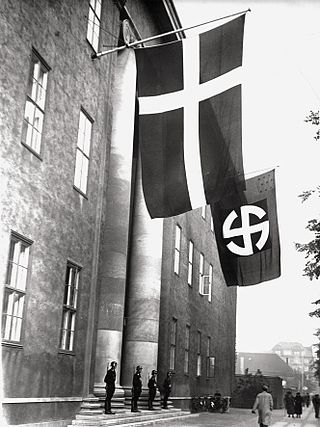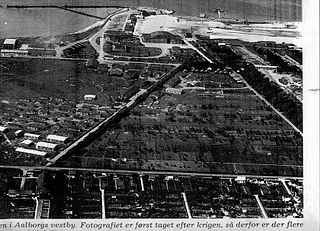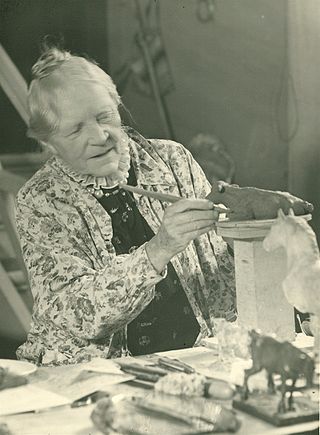
Odense is the third largest city in Denmark and the largest city on the island of Funen. As of 1 January 2024, the city proper had a population of 183,763 while Odense Municipality had a population of 209,078, making it the fourth largest municipality in Denmark. Eurostat and OECD have used a definition for the Metropolitan area of Odense, which includes all municipalities in the Province of Funen, with a total population of 504,066 as of 1 July 2022.

John, also known as Hans, was a Scandinavian monarch who ruled under the Kalmar Union. He was King of Denmark from 1481 to 1513, King of Norway from 1483 to 1513, and King of Sweden from 1497 to 1501. Additionally, from 1482 to 1513, he held the titles of Duke of Schleswig and Holstein, which he governed jointly with his brother, Frederick.

At the outset of World War II in September 1939, Denmark declared itself neutral, but that neutrality did not prevent Nazi Germany from occupying the country almost immediately after the outbreak of war; the occupation lasted until Germany's defeat. The decision to occupy Denmark was taken in Berlin on 17 December 1939. On 9 April 1940, Germany occupied Denmark in Operation Weserübung. The Danish government and king functioned in a relatively normal manner until 29 August 1943, when Germany placed Denmark under direct military occupation, which lasted until the Allied victory on 5 May 1945. Contrary to the situation in other countries under German occupation, most Danish institutions continued to function relatively normally until 1945. Both the Danish government and king remained in the country in an uneasy relationship between a democratic and a totalitarian system until 1943 when the Danish government stepped down in protest against German demands that included instituting the death penalty for sabotage.

The Danish resistance movements were an underground insurgency to resist the German occupation of Denmark during World War II. Due to the initially lenient arrangements, in which the Nazi occupation authority allowed the democratic government to stay in power, the resistance movement was slower to develop effective tactics on a wide scale than in some other countries.

Aalborg or Ålborg is Denmark's fourth largest urban settlement with a population of 119,862 in the town proper and an urban population of 143,598. As of 1 July 2022, the Municipality of Aalborg had a population of 221,082, making it the third most populous in the country after the municipalities of Copenhagen (capital) and Aarhus. Eurostat and OECD have used a definition for the metropolitan area of Aalborg, which includes all municipalities in the province of North Jutland, with a total population of 594,323 as of 1 July 2022.

Seefliegerhorst Aalborg was a German seaplane base at Aalborg during the occupation of Denmark, 1940 to 1945.

The German invasion of Denmark, was the German attack on Denmark on 9 April 1940, during the Second World War. The attack was a prelude to the invasion of Norway.
The Ranks and insignia of Royal Danish Army follows the NATO system of ranks and insignia, as does the rest of the Danish Defence. The ranks are based around German and French military terms.
Henrik Tagesen Reventlow, from Funen, was supporter of King Eric and leader of peasant army of 25000 during peasant revolt in Denmark, at the time of reign of King Christopher III of Denmark.

Operation Weserübung was the invasion of Denmark and Norway by Nazi Germany during World War II. It was the opening operation of the Norwegian Campaign.

Anne Marie Carl-Nielsen was a Danish sculptor. Her preferred themes were domestic animals and people, with an intense, naturalistic portrayal of movements and sentiments. She also depicted themes from Nordic mythology. She was "one of the first women to be taken seriously as a sculptor," a trend-setter in Danish art for most of her life. She was married to the Danish composer Carl Nielsen.

There are several museums in Aalborg, Denmark. These include a museum of modern art, a historical museum and a maritime museum. Together with the city's theatre, cultural centre and music interests, they constitute an important aspect of the municipality's recent focus on knowledge and culture.
Jan Persson worked as freelance photographer since 1962 for Danish newspapers and magazines in and around Copenhagen. Early on he specialized on documenting the jazz scene, later also the visiting beat and rock musicians who visited Copenhagen during the sixties and the seventies. His works have been documented in a series of books and exhibitions and his pictures are used on more than 1000 album and CD covers.

Knud Arne Jürgensen is a Danish music-, opera-, ballet- and theater historian, dramaturg, curator of exhibitions, senior researcher, critic, dr. phil.

The L-groups was a resistance group tasked with assassination of Danish collaborators and German forces occupying Denmark during the Second World War. The precursor to the group was established in 1940, but it was most active from 1944 to the end of the war. The group carried out at least 18 assassination operations and killed between 20 and 30 people. In 1945 the group was hard hit by arrests and killings of its members and further suffered a very high death-rate in the years immediately after the war with suicides and accidents killing a number of members. The group had strong ties to the Danish police, with 5 of its members being police officers.

The Munke Mølle is the oldest still functioning company in Denmark, being founded in 1135 as a water mill on the Odense River in Odense city. The mill has been a purveyor to 38 kings and 2 queens, and today produces bread and cake mixes.

Operation Safari was a German military operation during World War II aimed at disarming the Danish military. It led to the scuttling of the Royal Danish Navy and the internment of all Danish soldiers. Danish forces suffered 23–26 dead, around 40–50 injured, and 4,600 captured. Of the roughly 9,000 Germans involved, one was killed and eight wounded, although the number may have been 11 killed and 59 wounded.

The Western Regional Command was the overall command of all Royal Danish Army units in Jutland and on Funen. It was split into four military regions, and was responsible for the regional defence. In 1990, the Regional Commands were disbanded and control was collected at the newly created Army Operational Command.

The plunder of Nancowry' or the Battle of Nancowry was the British capture of the Danish colony at Nancowry Island in 1805.


















